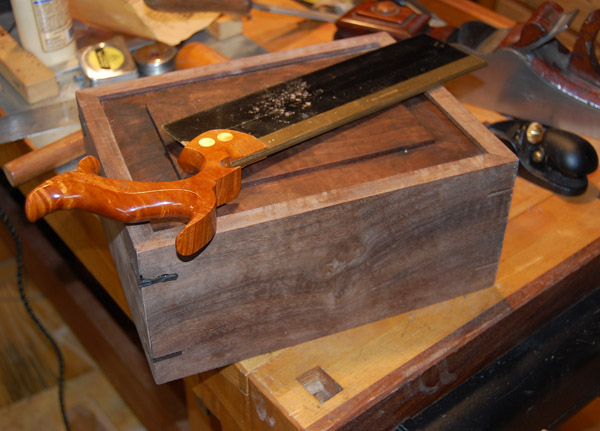 Soon after starting to do woodworking more sophisticated than pine bookshelves, I started
making boxes mostly as presents for friends. Below I have posted some photos and short
descriptions of some of them.
Soon after starting to do woodworking more sophisticated than pine bookshelves, I started
making boxes mostly as presents for friends. Below I have posted some photos and short
descriptions of some of them.
Early Boxes
 This box is one of the first boxes I made. It gave me a chance to experiment with dovetails, and
using handplanes to raise a panel (after a fashion). The lid surrounds a piece of glass that is
meant to allow displaying lace behind it.
This box is one of the first boxes I made. It gave me a chance to experiment with dovetails, and
using handplanes to raise a panel (after a fashion). The lid surrounds a piece of glass that is
meant to allow displaying lace behind it.
 This box is one I made not too long after the first. It is of cherry with ebony detailing and inlays.
I played around with laminating the pins of the dovetails with ebony so as to accent them. The
finish is tung oil and wax.
This box is one I made not too long after the first. It is of cherry with ebony detailing and inlays.
I played around with laminating the pins of the dovetails with ebony so as to accent them. The
finish is tung oil and wax.
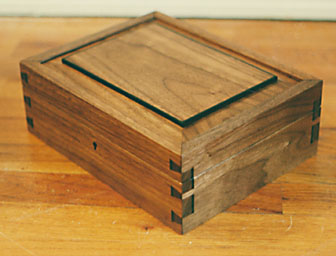 A dovetailed box of walnut and ebony.
A dovetailed box of walnut and ebony.
A Box For Jenny
 Another box of walnut and ebony, though here the walnut is nicely curly. This box is probably
my favorite, not because of the workmanship, but because of the wood. I was in a hurry to
complete this in time for Christmas, so I used mitered corners rather than dovetails, adding ebony
accent strips for decoration. The finish is tung oil, rubbed into the wood with fine wet or dry
sandpaper for the first several coats. Then more with a soft cloth, and finally wax. This brings
out the figure of the wood while filling the pores with sanding dust.
Another box of walnut and ebony, though here the walnut is nicely curly. This box is probably
my favorite, not because of the workmanship, but because of the wood. I was in a hurry to
complete this in time for Christmas, so I used mitered corners rather than dovetails, adding ebony
accent strips for decoration. The finish is tung oil, rubbed into the wood with fine wet or dry
sandpaper for the first several coats. Then more with a soft cloth, and finally wax. This brings
out the figure of the wood while filling the pores with sanding dust.
Later Boxes
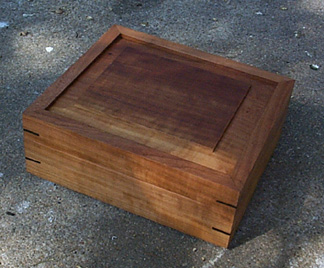 This is another box, made using the same techniques as the walnut box above. I finished it pretty
recently. The main wood used is curly cherry which I thought had some nice figure. The splines
are ebony slices.
This is another box, made using the same techniques as the walnut box above. I finished it pretty
recently. The main wood used is curly cherry which I thought had some nice figure. The splines
are ebony slices.
A Pure Handtool Experiment
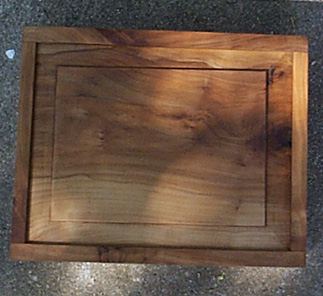
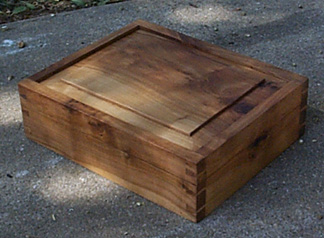 This box was somewhat of a challenge because I decided I would use no power tools to complete
it. It is made of some apple I had the good fortune to purchase several years back. The tree had
been sliced into 5/4 inch slabs and I did all of the thicknessing of the wood using hand planes.
Since the grain is rather wild with some knots this took a long time for me to finish. Then I raised
the panel in the lid using a couple of old panel raisers, and cut some dovetails with a dovetail
saw. This last step went less well than it usually does because I tried to make the box without
being as careful as I sometimes am to get everything uniform. If you measure old dovetails you
will sometimes find that the skilled craftspeople who made them measured by eye and yet you
don't see it except in very subtle ways. I erred a bit on the sloppy side, however, and had some
trouble marking the pins from the tails since the sides were not of uniform thickness. Still with a
bit of patching it looks alright. After gluing it up, I cut it open with a handsaw filed rip, and
planed the edges smooth. Tung oil and wax finish the box.
This box was somewhat of a challenge because I decided I would use no power tools to complete
it. It is made of some apple I had the good fortune to purchase several years back. The tree had
been sliced into 5/4 inch slabs and I did all of the thicknessing of the wood using hand planes.
Since the grain is rather wild with some knots this took a long time for me to finish. Then I raised
the panel in the lid using a couple of old panel raisers, and cut some dovetails with a dovetail
saw. This last step went less well than it usually does because I tried to make the box without
being as careful as I sometimes am to get everything uniform. If you measure old dovetails you
will sometimes find that the skilled craftspeople who made them measured by eye and yet you
don't see it except in very subtle ways. I erred a bit on the sloppy side, however, and had some
trouble marking the pins from the tails since the sides were not of uniform thickness. Still with a
bit of patching it looks alright. After gluing it up, I cut it open with a handsaw filed rip, and
planed the edges smooth. Tung oil and wax finish the box.
And More Boxes Yet
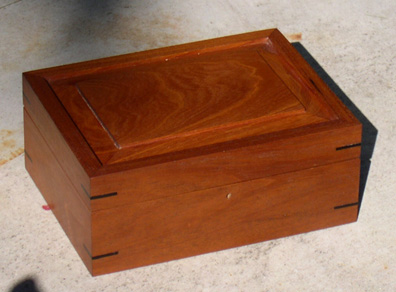 This is another box I made recently out of cherry with ebony trim.
This is another box I made recently out of cherry with ebony trim.
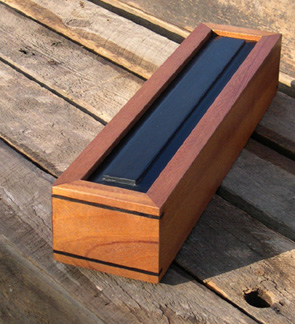
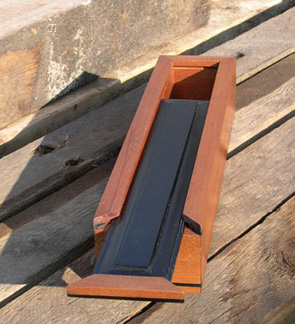
This is a box I made for storing crochet needles. It has a sliding lid of ebony on a cherry box with cherry details.
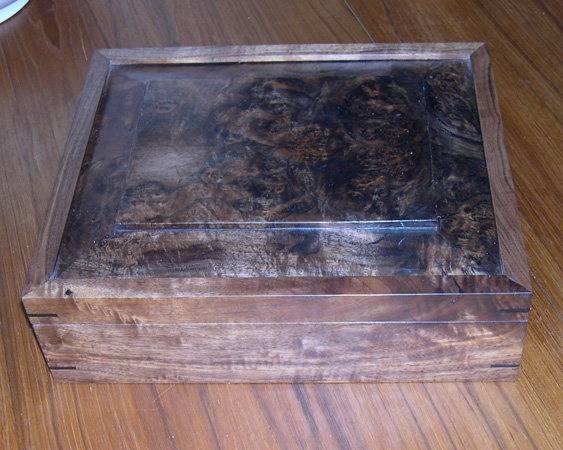
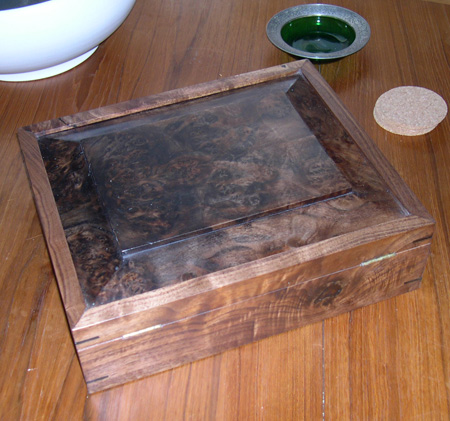
Another wedding box with a bookmatched claro walnut lid, black walnut sides, and ebony trim. The claro on the lid was wild enough that blackened epoxy was used to fill holes in the wood.


More claro walnut with no need to bookmatch, but resawn to get enough wood for the project. The front is actually from a different piece of wild figured wood, but it is a very nice piece of wood even if not quite the same as the rest. Used an old lock from an auction lot obtained a few years back to make it lock nicely, and Brusso hinges of good quality as well. I like the proportions on this one, as well as the wood. And it kept absorbing tung oil as I finished it so it got about seven coats before it was done.
Fly Tying Box

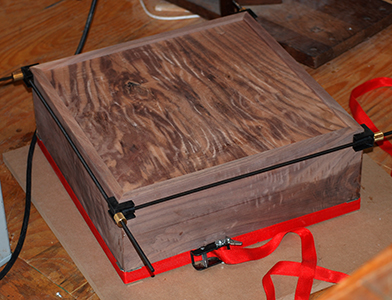
I made this first box from a bunch of gnarly walnut for a fund-raising auction for my local Trout Unlimited Chapter in 2016. It is an adaptation of a plan by a guy whose work can be found at http://lumberjocks.com/projects/25605. I modified his plan a good bit, using magnets rather than hinges to hold it together and adding the spool storage area under the lid, and an adapted collet for holding the vise stem. But I would not have come up with this version without seeing that one. He deserves a lot of credit for it.
Of course having put what seems like a hundred hours or so into it (filling the voids in the wood with dyed epoxy probably took a good part of that) I wound up bidding on it and won it. So then I got into tying flies to justify the expense and I've gone down a rabbit hole!


Undeterred by buying back my own box, I made a second box for an auction in 2017. It is much like the previous one but with lighter wood for the inner lid so as to better show up flies when people are tying. Fly tyers are picky and I got comments to the effect I needed to do that with my first box.
A New Design
Having one of the larger boxes led me to realize that the larger size was not an advantage. It makes it less portable and the extra materials storage is not as useful as it might seem given that you have to move the desk surface to get at what is inside. Better just to have it be smaller and use if for materials in their own storage boxes that can be taken out when you start tying. Making it a bit lower also makes it work better on a table. So I came up with this:
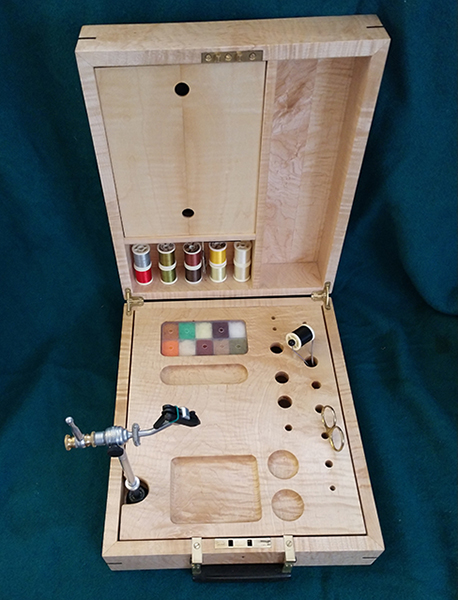



As you can see I made it out of curly maple most of which I got from www.curlymaple.com with ebony details. I am especially proud of the handle which I made of brass and ebony when I could not find anything I liked the look of for purchase. I also made one of the compartments fit the Renzetti vise that goes with this box.
The one below is the same basic design but with walnut for the box itself, though the workboard is still maple so that one can see what one is doing.
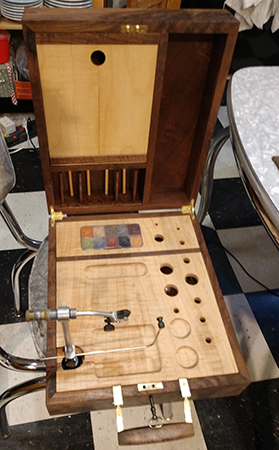
Curly Maple Box

I made this one for Tastes on the Tallgrass, a fundraiser for Spring Creek Paririe.
Fumed Oak Box
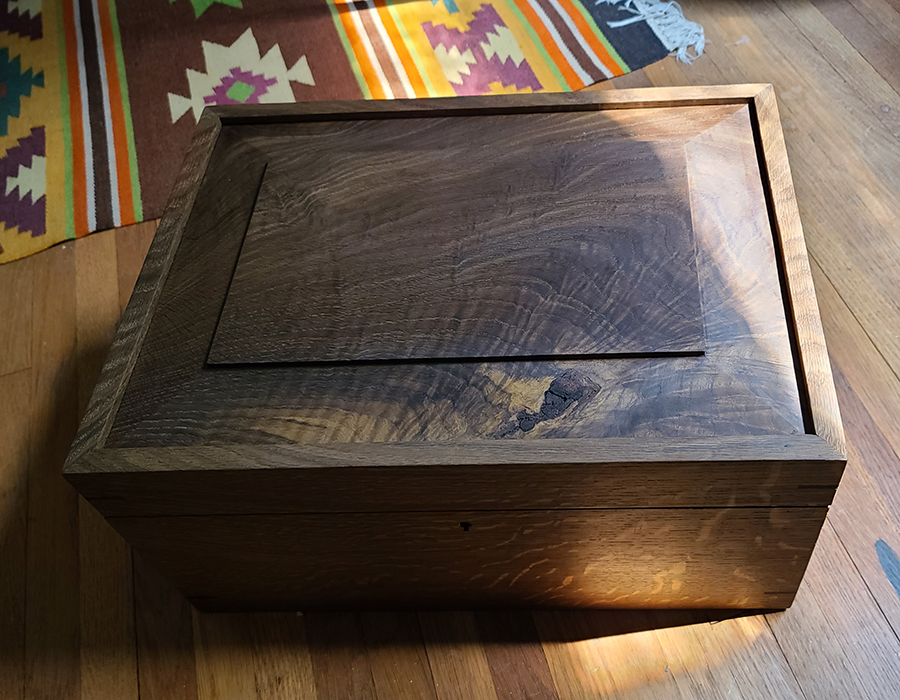
This is another box I made for Spring Creek Prairie to sell. This one I played around with fuming white oak, including a piece I had been saving for decades.
Not Exactly A Box
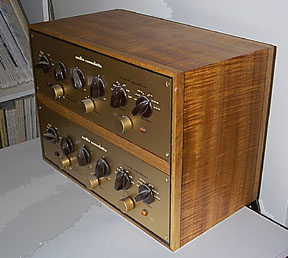 This box is actually a cabinet for an old set of mono preamps I got many years ago. The box
itself is made of plywood, veneered with curly koa veneer and detailed with ebony and ebonized
maple. Since I had not worked with veneered plywood before I got some help from my friend
Rich Christie who is a far better woodworker than I am.
This box is actually a cabinet for an old set of mono preamps I got many years ago. The box
itself is made of plywood, veneered with curly koa veneer and detailed with ebony and ebonized
maple. Since I had not worked with veneered plywood before I got some help from my friend
Rich Christie who is a far better woodworker than I am.
 Back to my Homepage.
Back to my Homepage.
 Back to my Woodworking Projects Page.
Back to my Woodworking Projects Page.
 Back to my Woodworking Page.
Back to my Woodworking Page.
 My Timberframe Cabin Page.
My Timberframe Cabin Page.  My Philosophy Page.
My Philosophy Page.